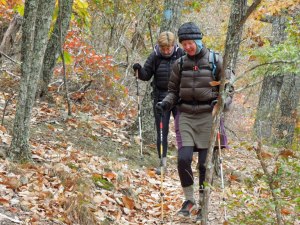By Jean Swann (Georgia Trail Dames)
November of 2014 brought a wonderful flurry of backpacking trips! Pine Mountain was my destination for two weekends in a row. I had backpacked once before with Joan West and others from the Trail Dames organization. This was my second opportunity. I arrived at F.D. Roosevelt State Park at Pine Mountain early in the day and took advantage of the extra time to do a little geocaching. The woods were beautifully arrayed in bright fall Crayola colors.


Joan was driving in from North Carolina, where she had just finished thru-hiking the 77- mile Foothills Trail. She met me at Dead Pine campsite at dusk, just as I was polishing off the last of my dinner. The evening was chilly, and it was almost dark, so she quickly hung her hammock, and we retired for the night at 6:30 p.m.!

I thought I would have a hard time going to sleep, but I drifted off in about 30 minutes, snug inside my 10-degree down sleeping bag. This was its maiden voyage, and I was really glad I took it because the overnight low was 23 degrees and Mark wasn’t there for me to put my cold feet on!
I slept until almost daylight, when a group of hikers noisily tramped along the nearby Pine Mountain Trail, probably heading for the Country Store for a hot breakfast. Joan and I met the two other Trail Dames who would be hiking with us – Tonya and Kelly – at the park office, and we were off to Dowdell Knob to do a gear shakedown. By the time we got on the trail, it was nearly lunchtime.

We left Rocky Point parking lot and headed west on the Pine Mountain Trail. There, the trail drops quickly amid huge chunks of rock embedded into the mountainside. At the bottom of our descent, we rock-hopped across Sparks Creek, discovering, in the process, late fall blossoms of the lovely Grass of Parnassus. The delicate white flower is actually not a grass but an herbaceous dicot.


After taking advantage of the photo op, we continued until the merry waters of Sparks Creek beckoned us to stop at a creekside campsite and eat our lunches. We left the pleasant creek valley and climbed the ridge on the switchbacking treadway, eventually reaching a parking lot, where Tonya bid us goodbye and headed home. Following the Boot Top Trail, Kelly, Joan and I eased back down the ridge into the valley of Bethel Creek, the scene of extreme tornado damage a few years ago. As the Boot Top Trail rejoined the Pine Mountain Trail, we passed a Boy Scout troop taking a breather. For the next mile and a half, we played leapfrog with them as first one group and then the other stopped for rests or photo sessions.

We reached Whiskey Still campsite in plenty of time to enjoy a leisurely dinner and once again shut down for the evening by 6:30. At dawn we were up and loading our packs to head back. The walk out to Mollyhugger Hill parking lot, where we had stashed a vehicle, was beautiful and only about three quarters of a mile. It was a great weekend trip!




